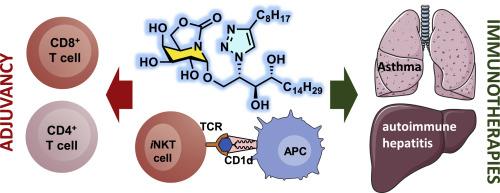当前位置:
X-MOL 学术
›
Eur. J. Med. Chem.
›
论文详情
Our official English website, www.x-mol.net, welcomes your
feedback! (Note: you will need to create a separate account there.)
α-GalCer sp2-iminoglycolipid analogs as CD1d-dependent iNKT modulators: Evaluation of their immunotherapeutic potential in murine models of asthma and autoimmune hepatitis
European Journal of Medicinal Chemistry ( IF 6.0 ) Pub Date : 2024-11-15 , DOI: 10.1016/j.ejmech.2024.117060 Alan Chuan-Ying Lai, Manuel González-Cuesta, Chieh-Hsin Ho, Po-Yu Chi, Ko-Chien Wu, Gabriel Rocha, Juan C. Muñoz-García, Jesús Angulo, José M. García Fernández, Ya-Jen Chang, Carmen Ortiz Mellet
European Journal of Medicinal Chemistry ( IF 6.0 ) Pub Date : 2024-11-15 , DOI: 10.1016/j.ejmech.2024.117060 Alan Chuan-Ying Lai, Manuel González-Cuesta, Chieh-Hsin Ho, Po-Yu Chi, Ko-Chien Wu, Gabriel Rocha, Juan C. Muñoz-García, Jesús Angulo, José M. García Fernández, Ya-Jen Chang, Carmen Ortiz Mellet

|
Invariant natural killer T (iNKT) cells are a subset of innate T cells displaying powerful immunomodulatory functions. Despite extensive preclinical research on the use of iNKT agonist and antagonist for various diseases, translating these findings into successful clinical applications has proven challenging, leaving no approved treatments to date. Efforts to optimize therapeutic outcomes by developing alternative glycolipids to α-galactosylceramide (α-GalCer or KRN7000), the prototypical iNKT antigen, have shown improved preclinical results. However, significant obstacles remain, including the relatively laborious synthesis of α-glycosides and their vulnerability to degradation by α-glycosidases. To overcome these limitations, we explored the use of sp2-iminosugars, a class of glycomimetics, to replace the carbohydrate moiety in α-GalCer-like glycolipids. This substitution offers enhanced biostability and precise control over α-selectivity in glycosylation reactions. The resulting sp2-iminoglycolipids (sp2-IGLs) were tested for their immunomodulatory effects, demonstrating the ability to bind the α-GalCer binding site on the CD1d protein in antigen-presenting cells (APCs), and functioning as iNKT antagonists in α-GalCer-stimulated splenocytes. Notably, analogs featuring a 4-alkyl-1,2,3-aminotriazol-1-yl segment in place of the C25 N-acyl tail in α-GalCer additionally exhibited mild agonistic activity in the absence of α-GalCer stimulation. Computational studies support the formation of stable CD1d– sp2-IGL and CD1d – sp2-IGL – T-cell receptor complexes, with significant differences in the dynamics depending on the glycone nature and lipid tail length. These findings provide a molecular rationale for the observed experimental data. Furthermore, in vivo studies using murine models of asthma and autoimmune hepatitis have identified promising sp2-IGL candidates for further development in immunotherapy.
中文翻译:

α-GalCer sp2-亚氨基糖脂类似物作为 CD1d 依赖性 iNKT 调节剂:评估它们在哮喘和自身免疫性肝炎小鼠模型中的免疫治疗潜力
不变的自然杀伤 T 细胞 (iNKT) 是先天性 T 细胞的一个亚群,具有强大的免疫调节功能。尽管对 iNKT 激动剂和拮抗剂治疗各种疾病进行了广泛的临床前研究,但将这些发现转化为成功的临床应用已被证明具有挑战性,迄今为止还没有获得批准的治疗方法。通过开发 α-半乳糖神经酰胺(α-GalCer 或 KRN7000)(原型 iNKT 抗原)的替代糖脂来优化治疗结果的努力已显示出改善的临床前结果。然而,仍然存在重大障碍,包括 α-糖苷的相对费力合成以及它们容易被 α-糖苷酶降解。为了克服这些限制,我们探索了使用 sp2-亚氨基糖(一类拟糖剂)来替代 α-GalCer 样糖脂中的碳水化合物部分。这种取代提供了增强的生物稳定性和对糖基化反应中α选择性的精确控制。测试所得的 sp2-亚氨基糖脂 (sp 2-IGLs) 的免疫调节作用,证明其能够在抗原呈递细胞 (APCs) 中结合 α-GalCer 蛋白上的 CD1d 蛋白,并在 α-GalCer 刺激的脾细胞中充当 iNKT 拮抗剂。值得注意的是,在没有 α-GalCer 刺激的情况下,具有 4-烷基-1,2,3-氨基三唑-1-基片段代替 α-GalCer 中 C25N-酰基尾部的类似物还表现出轻微的激动活性。 计算研究支持稳定的 CD1d-sp 2-IGL 和 CD1d-sp2-IGL -T 细胞受体复合物的形成,动力学差异很大,具体取决于糖苷系性质和脂质尾部长度。这些发现为观察到的实验数据提供了分子理论依据。此外,使用哮喘和自身免疫性肝炎小鼠模型的体内研究已经确定了有前途的 sp2-IGL 候选者,用于免疫治疗的进一步开发。
更新日期:2024-11-19
中文翻译:

α-GalCer sp2-亚氨基糖脂类似物作为 CD1d 依赖性 iNKT 调节剂:评估它们在哮喘和自身免疫性肝炎小鼠模型中的免疫治疗潜力
不变的自然杀伤 T 细胞 (iNKT) 是先天性 T 细胞的一个亚群,具有强大的免疫调节功能。尽管对 iNKT 激动剂和拮抗剂治疗各种疾病进行了广泛的临床前研究,但将这些发现转化为成功的临床应用已被证明具有挑战性,迄今为止还没有获得批准的治疗方法。通过开发 α-半乳糖神经酰胺(α-GalCer 或 KRN7000)(原型 iNKT 抗原)的替代糖脂来优化治疗结果的努力已显示出改善的临床前结果。然而,仍然存在重大障碍,包括 α-糖苷的相对费力合成以及它们容易被 α-糖苷酶降解。为了克服这些限制,我们探索了使用 sp2-亚氨基糖(一类拟糖剂)来替代 α-GalCer 样糖脂中的碳水化合物部分。这种取代提供了增强的生物稳定性和对糖基化反应中α选择性的精确控制。测试所得的 sp2-亚氨基糖脂 (sp 2-IGLs) 的免疫调节作用,证明其能够在抗原呈递细胞 (APCs) 中结合 α-GalCer 蛋白上的 CD1d 蛋白,并在 α-GalCer 刺激的脾细胞中充当 iNKT 拮抗剂。值得注意的是,在没有 α-GalCer 刺激的情况下,具有 4-烷基-1,2,3-氨基三唑-1-基片段代替 α-GalCer 中 C25N-酰基尾部的类似物还表现出轻微的激动活性。 计算研究支持稳定的 CD1d-sp 2-IGL 和 CD1d-sp2-IGL -T 细胞受体复合物的形成,动力学差异很大,具体取决于糖苷系性质和脂质尾部长度。这些发现为观察到的实验数据提供了分子理论依据。此外,使用哮喘和自身免疫性肝炎小鼠模型的体内研究已经确定了有前途的 sp2-IGL 候选者,用于免疫治疗的进一步开发。


















































 京公网安备 11010802027423号
京公网安备 11010802027423号